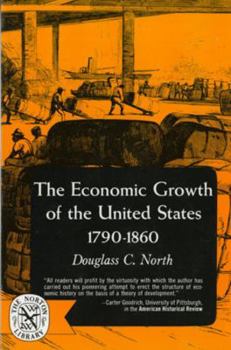The Economic Growth of the United States: 1790-1860
Select Format
Select Condition 
Book Overview
On the eve of the Civil War the United States had already achieved rapid and sustained economic expansion. We had filled out our territorial boundaries, and the frontier was already encroaching upon the parched lands in the lee of the Rocky Mountains and moving east of the Sierra Nevadas. We were an industrial nation second only to Britain in manufacturing. Our expansion had been matched by an acceleration of economic well-being. The obstacles to...
Format:Paperback
Language:English
ISBN:0393003469
ISBN13:9780393003468
Release Date:January 1966
Publisher:W. W. Norton & Company
Length:322 Pages
Weight:0.65 lbs.
Dimensions:0.9" x 4.9" x 8.0"
Customer Reviews
1 rating
Basic
Published by Thriftbooks.com User , 16 years ago
This excellent book is a description and analysis of the major economic trends in the early republic. This book consists of a large amount of economic data and a relatively simple theory. Over one third of the book consists of data tables used to develop North's argument. The relatively simple theory is that export of a single primary product, cotton, provided the platform of much American economic development and determined the contours of regional and national economic development. North divides his study period into 3 periods. There is much of the Napoleonic wars, when the American economy was impelled forward by a boom in shippling made possible by neutral status. Then the period from the end of the War of 1812 to the mid-1840s, which might be described as the age of cotton. Finally, from the mid-1840s to the Civil War, a period of considerable economic diversification, accelerating industrialization, and Northeastern-Western economic integration. North divides the USA into 3 regions. The cotton and other plantation staple dominated South, the mercantile and industrializing Northeast (New England and Middle Atlantic states), and the largely more diversified agricultural West. North shows these divisions as emerging fairly early, before the cotton boom era. North documents very nicely the major trends in this period, the increasing population, geographic enlargement, and increasing economic vigor of the USA. North emphasizes the key role of cotton production for the international, particularly British market, and the increasing involvement of Americans in both international, national, and regional markets. Cotton production and exports led to increased mercantile/financial activity in the Northeast, played a key role in the development of the leading edge of the industrial revolution in the USA, the New England textile industry, and drove Western expansion by demand for agricultural products in the South. But the cotton plantation system also meant that the South developed many features of a colonial economy dominated by a backward looking oligarchy. After the 1840s, increasing industrialization, urbanization, and market articulation, coupled with railroad and telegraph development would draw the Northeast and West together with the South's key role in American economic life diminishing. North's analysis reveals the importance of some strictly non-economic factors. Given the key role of cotton exports in the emergence of the American economy, coerced slave labor and land expropriated from Southern Indians were key factors in American economic success. In the development of the Northeast and West, government action to develop improved transportation was crucial, particularly canal development. North also comments on the importance of a well educated population in industrial innovation in the Northeast, something that arises directly from the Puritan emphasis on education. Clearly written with an assembly of easy to r




